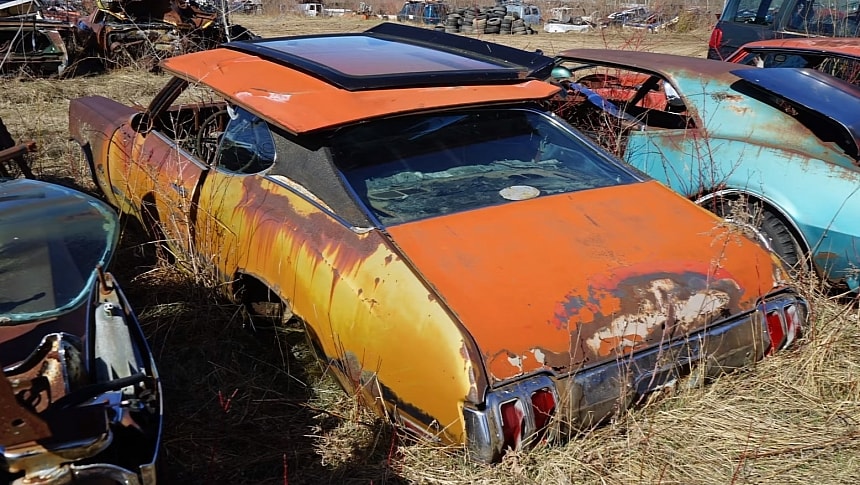In September 1963, Pontiac introduced the high-performance GTO package on the LeMans. The vehicle's unexpected success prompted Oldsmobile to develop a competitor by the end of the 1964 model year. That's how the Cutlass-based 442 was born.
The nameplate provided the division with a beefed-up midsize offering throughout the golden muscle car era, spawning a few iconic rigs in the process. The Hurst/Old is perhaps the most iconic, followed by the W30 version. Unlike the former, which was developed by Hurst Performance and had a unique appearance, the W30 was only about under-the-hood upgrades.
Oldsmobile introduced the W30 engine in 1966. It featured a hotter cam and an induction system that fed cool air to the carburetors via tubing from the front grille. Rated at 360 horsepower, the mill found its way on only 54 cars that year, but an additional 97 units were fitted with the beefed-up V8 by dealers.
1967 saw Oldsmobile produce notably more W30s to meet NHRA homologation rules. The company built 502 examples, but the carburetor setup was changed from "tri-power" to a four-barrel. W30 production rose to 1,426 units in 1968 before dropping to 1,063 cars in 1969.
In 1970, the year known as "the pinnacle of Oldsmobile performance," the 442 W30 found 3,100 homes. Now featuring the massive 455-cubic-inch (7.5-liter) V8, the W30 came with 370 horsepower and a whopping 500 pound-feet (680 Nm) of torque on tap.
Even though it's much more common than previous W30 cars, the 1970 version is still a rare gem compared to the regular 442 (more than 19,000 produced). However, that didn't prevent many W30s from being abandoned in junkyards over the years. The derelict example you see here is one of the unlucky ones.
Documented by Ryat Brutt of YouTube's "Auto Archaeology," this high-performance midsize is spending its retirement years in a junkyard hidden away somewhere in Michigan (the exact location isn't provided). It's parked among many other GMs from the 1960s and 1970s and appears to be the rarest and most desirable vehicle from this yard.
Unfortunately, the 442 is in rough shape. The vehicle was reportedly retired following an engine failure that caused a fire. The car is missing the entire front clip (the engine is obviously gone), and most of the remaining body panels are rusty. The interior appears to be largely complete, but it's not a pretty sight either. And since it's sitting close to the ground, it's safe to say that the undercarriage is also rusty.
The Olds appears to be a Holiday Coupe (hardtop), which makes it the most common of the W30 bunch. The company produced 2,574 hardtops in 1970, alongside 262 post coupes and 264 convertibles. Hardtop production can be further split into 1,032 four-speed manuals and 1,542 automatics, but there's no info on the gearbox of this car.
Likely sitting for a few decades, this 442 is too far gone at first glance. However, our host believes it can still be saved. What do you think? Is this rare 442 W30 salvageable, or should it rot away in this junkyard?
Oldsmobile introduced the W30 engine in 1966. It featured a hotter cam and an induction system that fed cool air to the carburetors via tubing from the front grille. Rated at 360 horsepower, the mill found its way on only 54 cars that year, but an additional 97 units were fitted with the beefed-up V8 by dealers.
1967 saw Oldsmobile produce notably more W30s to meet NHRA homologation rules. The company built 502 examples, but the carburetor setup was changed from "tri-power" to a four-barrel. W30 production rose to 1,426 units in 1968 before dropping to 1,063 cars in 1969.
In 1970, the year known as "the pinnacle of Oldsmobile performance," the 442 W30 found 3,100 homes. Now featuring the massive 455-cubic-inch (7.5-liter) V8, the W30 came with 370 horsepower and a whopping 500 pound-feet (680 Nm) of torque on tap.
Even though it's much more common than previous W30 cars, the 1970 version is still a rare gem compared to the regular 442 (more than 19,000 produced). However, that didn't prevent many W30s from being abandoned in junkyards over the years. The derelict example you see here is one of the unlucky ones.
Documented by Ryat Brutt of YouTube's "Auto Archaeology," this high-performance midsize is spending its retirement years in a junkyard hidden away somewhere in Michigan (the exact location isn't provided). It's parked among many other GMs from the 1960s and 1970s and appears to be the rarest and most desirable vehicle from this yard.
Unfortunately, the 442 is in rough shape. The vehicle was reportedly retired following an engine failure that caused a fire. The car is missing the entire front clip (the engine is obviously gone), and most of the remaining body panels are rusty. The interior appears to be largely complete, but it's not a pretty sight either. And since it's sitting close to the ground, it's safe to say that the undercarriage is also rusty.
The Olds appears to be a Holiday Coupe (hardtop), which makes it the most common of the W30 bunch. The company produced 2,574 hardtops in 1970, alongside 262 post coupes and 264 convertibles. Hardtop production can be further split into 1,032 four-speed manuals and 1,542 automatics, but there's no info on the gearbox of this car.
Likely sitting for a few decades, this 442 is too far gone at first glance. However, our host believes it can still be saved. What do you think? Is this rare 442 W30 salvageable, or should it rot away in this junkyard?









